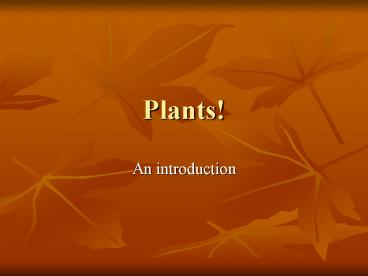Plants! - PowerPoint PPT Presentation
Title:
Plants!
Description:
Plants! An introduction Plants All plants are multi-cellular,autotrophic eukaryotes. Lots of cells. Produces its own food using chlorophyll. Has a Nucleus . – PowerPoint PPT presentation
Number of Views:108
Avg rating:3.0/5.0
Title: Plants!
1
Plants!
- An introduction
2
Plants
- All plants are multi-cellular,autotrophic
eukaryotes. - Lots of cells.
- Produces its own food using chlorophyll.
- Has a Nucleus .
3
Plants
- The plant kingdom is one of the largest groups of
living things with more than half a million
different species. - Examples include multi-cellular algae, moss,
ferns, flowering plants, and trees.
4
Plants
- Plants are not able to independently move from
one place to another. - Plants have dedicated tissues
- Groups of cells to perform specific functions.
- All plants require male and female parts to
reproduce.
5
Plant Classifications
- There are only 4 distinct types of plants.
- Non-vascular seedless plants
- Vascular seedless
- Vascular non-flowering (like pine cones)
- Vascular flowering
6
Plant Classifications
- Non-Vascular Seedless
- Plants that do not use a system of vessels to
transport water and nutrients between different
parts of the plant. - Non-vascular plants are the simplest of all land
dwelling plants. - All are low-growing.
- First plants on land.
7
Plant Classifications
- Non-Vascular Seedless
- Mosses
http//visual.merriam-webster.com/images/plants-ga
rdening/plants/moss/examples-mosses.jpg
8
Plant Classifications
- Non-Vascular Seedless
- Liverworts
http//www.sheffield.ac.uk/content/1/c6/05/24/91/l
iverworts-close-up-web.jpg
9
Plant Classifications
- Non-Vascular Seedless
- Hornworts
http//www.ucmp.berkeley.edu/plants/hornwortyoung.
jpg
10
Plant Classifications
- Seedless, Vascular
- The plants in this group have a true vascular
transport system for the movement of water and
nutrients - They are "seedless" because they reproduce by
means of spores. - Spore
- a reproductive structure that is adapted for
dispersal.
11
Plant Classifications
- Seedless, Vascular
- Ferns
http//kmacphoto.net/ferns.jpg
12
Plant Classifications
- Seedless, Vascular
- Horsetails
http//www.library.illinois.edu/vex/toxic/hrstail/
6-29-19.jpg
13
Plant Classifications
- Seedless, Vascular
- Whisk Ferns
http//www.palaeos.com/Plants/Images/Psilotum.jpg
14
Plant Classifications
- Flowering, Vascular with Seeds
- Angiosperms
http//www.biology.iastate.edu/Courses/211L/Anthop
h/floweringplant
15
Angiosperm Life Cycle
tutorvista.com
16
Angiosperm Life Cycle
- Parts of a seed.
http//extension.missouri.edu/p/MG3
17
Plant Classifications
- Non-Flowering, Vascular with Seeds
- Gymnosperms
http//biology.clc.uc.edu/graphics/taxonomy/plants
/spermatophyta/Gymnosperms/
18
Gymnosperm Life Cycle
tutorvista.com
19
Gymnosperm Life Cycle
- Parts of a cone.
20
Parts of a Plant
- LEAF
- Absorbs sunlight for plant to convert to energy.
- Stores chlorophyll and is the site of
photosynthesis. - Contain Stoma
- a pore, found in the leaf and stem of plants that
is used for gas exchange - Can be wide and flat (as in a maple leaf) or long
and thin (as in a cactus spine) - Covered with a water proof layer called the
cuticle
21
Parts of a Plant
- LEAF
http//www.woodlands.co.uk/images/tree-identificat
ion/leafdiagram.jpg
22
Parts of a Plant
- LEAF
http//www.molecularexpressions.com/cells/ leaftis
sue/images/leafstructurelargefigure1.jpg
23
Parts of a Plant
- STEM
- supports leaves and flowers.
- carries water, minerals, and food up and down
between the plants leaves and roots. - can be small and thin (as in a flower) or tall
and thick (as in a tree). - helps plant grow in a direction toward energy
sources. - has light-sensitive tips to ensure growth toward
light.
24
Parts of a Plant
- STEM
http//paintthelight.net/BotanyProject/Activities/
images/2004_gallery_stem_diagram.jpg
25
Parts of a Plant
- ROOT
- Grows down into the soil or water.
- Anchors plant to the earth.
- Absorbs water and minerals needed for growth.
- Includes varieties, based on structure
- Taproots single large root with a few smaller,
branching roots. - Fibrous roots many small roots branching off in
different directions.
26
Parts of a Plant
- Taproot
http//upload.wikimedia.org/wikipedia/en/7/7a/Plan
t_taproots.jpg
27
Parts of a Plant
- Fibrous roots
http//www.croplangenetics.com/stellent/groups/pub
lic/documents/web_content/ecmd0014867.jpg
28
Parts of a Plant
- Vascular System
- Xylem
- Used for water and mineral transport
- Phloem
- Used for sugar/food transport
29
Parts of a Plant
- Vascular System
http//www.treeboss.net/images/bark_cross_section.
jpg
30
Photosynthesis
- Photosynthesis is the process by which plants
take energy from the sun and combine carbon
dioxide and water to produce food. - Water Carbon Dioxide Light ---gt Sugar Oxygen































